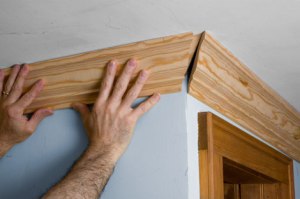Quote of the Day
I have always imagined that paradise will be a kind of library.
— Jorge Luis Borges
Introduction
I have just returned from putting up crown molding at brother's house. It is always fun working with my brothers. In many ways, we are little different today than we were 40 years ago. During this task, I encountered a wall corner that was not square. Let's talk about how you can measure and bisect this angle. You need to bisect the angle when you want to cut the molding to fit around the corner (Figure 1).
Background
Why Do You Need to Bisect the Angle?
You need to cut the molding at an angle that bisects the wall angle because the two molding cross-sections must be identical to match up when you join them together.
Why Isn't the Wall Angle 90°?
Some walls are designed to meet at angles other than 90°. Most walls are designed to meet at 90° but are not exactly at 90° because of how drywall is installed. Figure 2 shows a detailed drawing of a drywall corner constructed using corner bead.
The walls do not meet at 90° because
- The wall framing is not perfectly square (i.e. 90°)
- The process of skimming the wall intersection with drywall compound results in a bulge at the joint.
Analysis
Approach
I have used my approach for so long that I have forgotten where I learned it. Here is a link that does a nice job describing the method I use. The approach is straightforward:
- Place two flat pieces of wood of the same width along both walls as shown in Figure 3 (use thin wood so it does not teeter as much).
- Draw lines along both sides of the upper piece of wood onto the bottom piece of wood.
- Take the wood pieces down from the ceiling
- Draw a diagonal connecting the two lines from above as shown in Figure 4. The diagonal is the angle bisector.
- Cut the molding on the angle bisector.
Geometric Proof of the Method
Figure 5 shows how we can prove that we have bisected the angle using geometrical methods. There is nothing special in the proof, just remember your basic properties of isosceles triangles.
Conclusion
I wish all my walls met at 90°, but they don't. This method has allowed me to put up crown molding with just a little bit of trouble -- there always is some finessing that has to be done.





